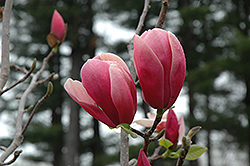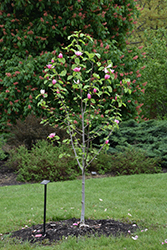Height: 20 feet
Spread: 10 feet
Sunlight:
![]()
![]()
Hardiness Zone: 6b
Other Names: Rosemarie Magnolia
Description:
A hybrid magnolia selected for its lovely rose-pink cup-shaped flowers with white insides, appearing in spring before the leaves; can be maintained as a large shrub or small tree, makes a fine ornamental specimen for smaller yards
Ornamental Features
Rose Marie Magnolia is smothered in stunning fragrant rose cup-shaped flowers with white overtones held atop the branches in early spring before the leaves. It has dark green deciduous foliage. The large pointy leaves turn coppery-bronze in fall.
Landscape Attributes
Rose Marie Magnolia is a multi-stemmed deciduous tree with a shapely oval form. Its relatively coarse texture can be used to stand it apart from other landscape plants with finer foliage.
This is a relatively low maintenance tree, and should only be pruned after flowering to avoid removing any of the current season's flowers. It has no significant negative characteristics.
Rose Marie Magnolia is recommended for the following landscape applications;
- Accent
- Shade
- Hedges/Screening
Planting & Growing
Rose Marie Magnolia will grow to be about 20 feet tall at maturity, with a spread of 10 feet. It has a low canopy with a typical clearance of 2 feet from the ground, and is suitable for planting under power lines. It grows at a medium rate, and under ideal conditions can be expected to live for 50 years or more.
This tree does best in full sun to partial shade. It requires an evenly moist well-drained soil for optimal growth, but will die in standing water. It is not particular as to soil type, but has a definite preference for acidic soils. It is quite intolerant of urban pollution, therefore inner city or urban streetside plantings are best avoided. Consider applying a thick mulch around the root zone in winter to protect it in exposed locations or colder microclimates. This particular variety is an interspecific hybrid.
Disclaimer - This resource is provided for informational purposes only and does NOT reflect current availability. Inventory varies seasonally, so we cannot guarantee that every plant will be in stock at all times - please contact your favourite GardenWorks location directly for current availability. It does not include our entire inventory of plants, so be sure to visit GardenWorks to see varieties that may not be represented on this list.


